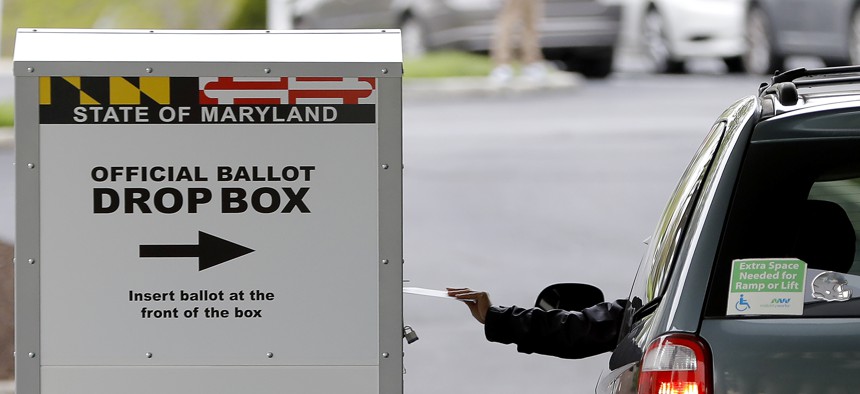The Cost of an Election Amid the Coronavirus Outbreak

A motorist drops off a mail-in ballot outside of a voting center during the 7th Congressional District special election, Tuesday, April 28, 2020, in Windsor Mill, Md. AP Photo/Julio Cortez

Connecting state and local government leaders
A new report lays out some of the costs associated with actions states are taking to protect voters and poll workers from the spread of the virus.
From paying for postage on absentee ballots to purchasing new ballot drop boxes or mail sorting equipment, state and local elections offices will incur significant expenses as they overhaul procedures to limit public health risks tied to voting during the coronavirus pandemic.
A new analysis of five states’ election-related needs estimates the price tag for those states is at least $414 million—an indication, election experts said, that much more federal funding will be needed to cover the associated costs.
The report was released Thursday by Alliance for Securing Democracy, the Brennan Center for Justice, University of Pittsburgh Institute for Cyber Law, Policy, and Security, and R Street Institute. It estimates costs for five states’ upcoming elections as follows:
- Georgia: $110 million to $124 million for five elections
- Michigan: $95 million to $104 million for three elections
- Missouri: $59 million to $67 million for three elections
- Ohio: $70 million to $82 million for three elections (including April 28 primary)
- Pennsylvania: $79 million to $90 million for two elections
The CARES Act passed last month allocates $400 million for election security efforts nationwide, but the authors of the report say their analysis indicates far more will be needed.
“The funding Congress has provided so far is an important start, but it won’t come close to
covering the needs of the states we studied to protect their elections during the pandemic, let alone what is needed for the entire country,” said Elizabeth Howard, Counsel in the Democracy Program at the Brennan Center for Justice.
The report’s cost estimates are based on interviews with both elections officials and vendors, as well as voter turnout estimates.
If local election authorities do not receive more funding, some said it could be difficult to recruit and train poll workers and voters who do come to cast ballots in person may be stuck in long lines.
Tina Barton, the city clerk for Rochester Hills, Michigan said her biggest concern is keeping poll workers safe.
“How will I keep them safe if I don’t have the funding to buy what they need?” she said during a call Thursday with reporters.
If she can’t afford the necessary cleaning supplies and protective gear, she envisions running into difficulties recruiting people to staff the polls on Election Day.
In Weber County, Utah, less funding will translate to consolidating polling places, which in turn could increase the amount of time voters will have to wait to cast ballots, said Clerk Auditor Ricky Hatch.
“No funding means long lines,” he said.
Utah, which regularly sees 90% of its voters cast ballots by mail, has eliminated in-person voting this year. So, Hatch’s reference to long lines involves drive-thru polling locations where registered voters could pick up ballots, fill them out in their vehicles and then return them to drop boxes.
At the outset of the coronavirus outbreak, states delayed primary elections as they scrambled to find ways to limit physical contact at polling places and to expand vote-by-mail options. Now many of those states are fast approaching the delayed primary dates, while others are preparing for the presidential election in November.
For states that expand vote-by mail options, the report said local jurisdictions “will need more equipment, space, and staff to handle a substantial increase in absentee ballot use.” Automated letter openers will cost $1,000, for example. While mail sorting equipment for jurisdictions with more than 25,000 residents will cost $100,000, the report said.
In states that plan to send voters absentee ballot applications, the postage costs range from 45 cents to 60 cents per voter. The cost for the materials sent to voters including the ballot, instructions and envelopes ranges up to $1.89 per voter. Postage costs to mail the ballots range from $1.15 to $2.38 per voter, and more if states cover the cost of return postage.
For states that make ballot drop boxes an option, the report recommends each jurisdiction will need one drop box for every 15,000 voters. The cost of the boxes can range from $7,000 to $10,000 to purchase and install.
It will also cost more to facilitate in-person voting.
“Based on interviews with election officials, information from vendors, and publicly available information, we estimate that personal protective equipment (PPE) and cleaning supplies would cost an additional $170 per precinct,” the report states.
Pennsylvania officials told the report’s authors that the supplies would cost an additional $1.2 million per election across the state.
Andrea Noble is a staff correspondent with Route Fifty.

NEXT STORY: Rural, Intercity Bus Companies Hit Hard by Pandemic




